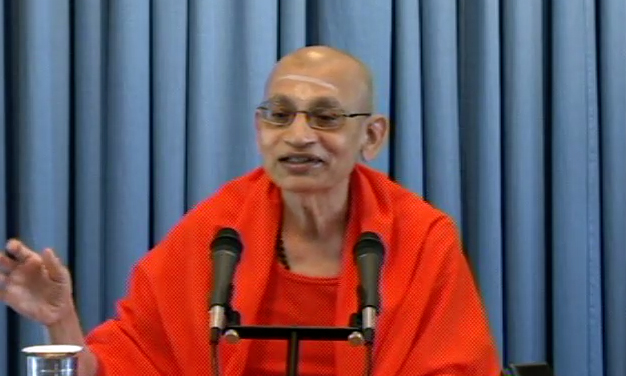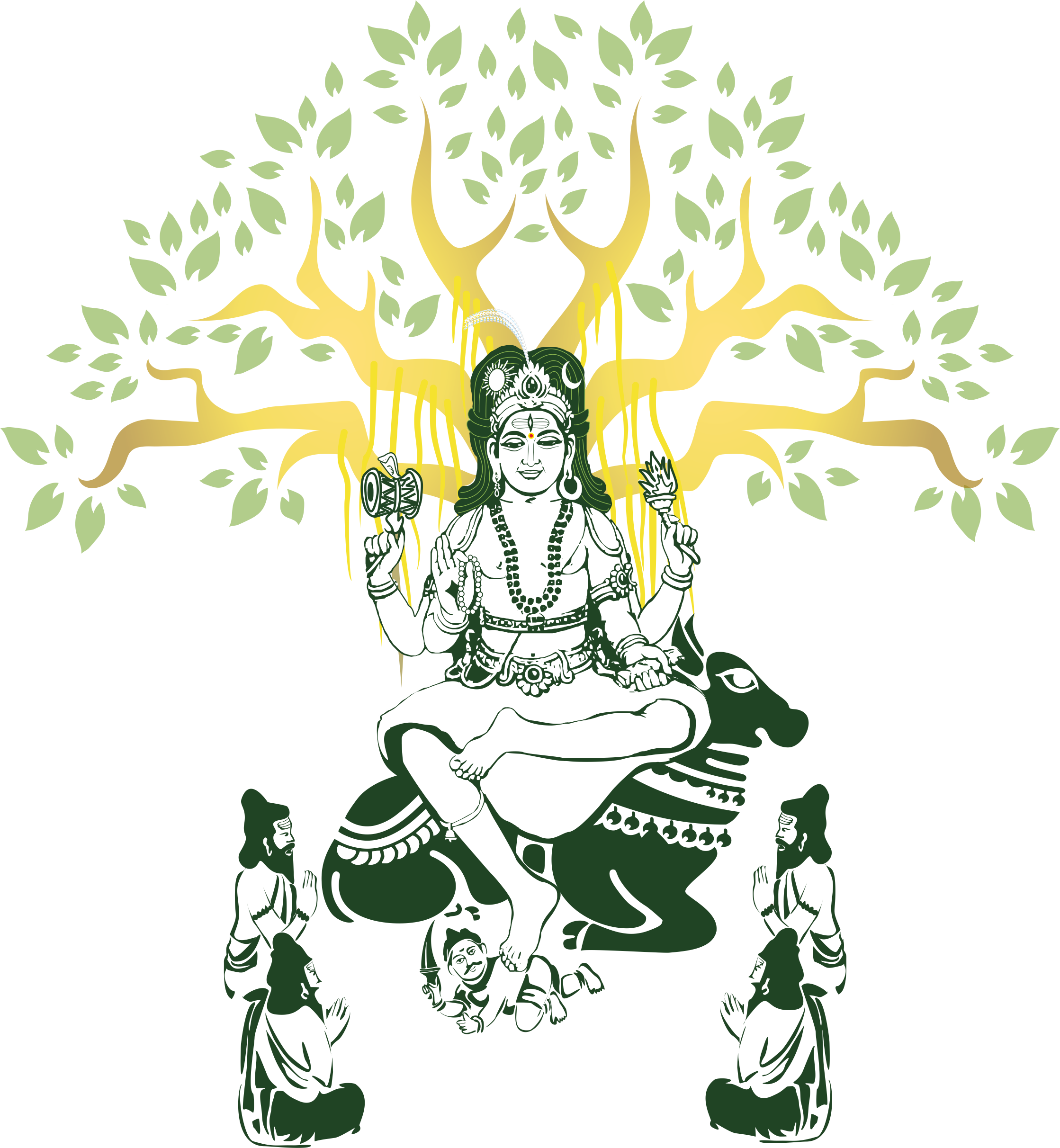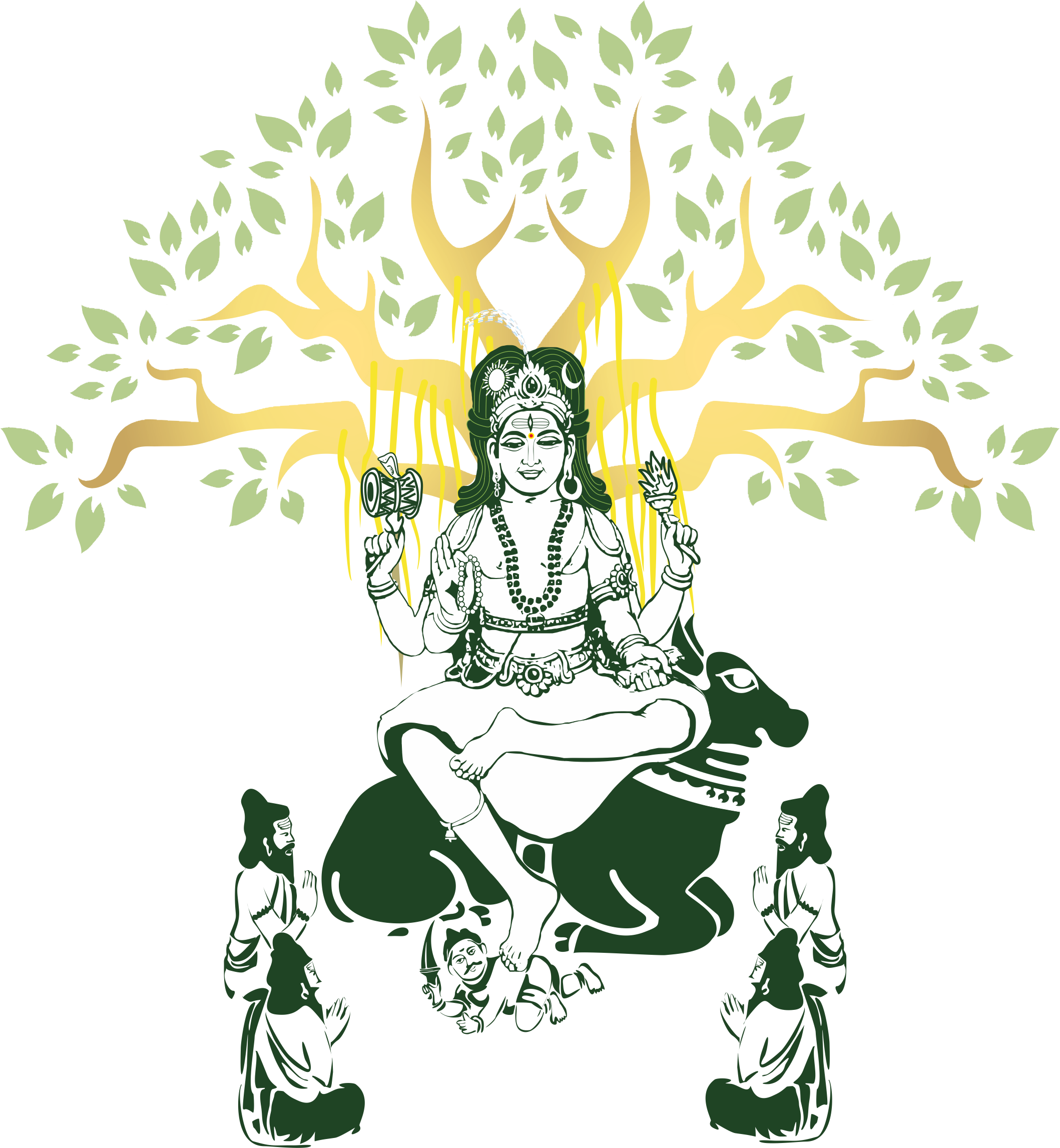Sevā Bhāva ~ An Attitude of Service (text)
by Swami Viditatmananda Saraswati

Pūjya Śrī Swami Dayananda Saraswati established AIM for Seva in 2000. The idea for starting this movement came
from a conversation with an elderly woman in Anaikkati, a village in southern India. She appealed to Swamiji to help
educate rural children as they did not have schools where they lived, and they did not know how to educate the local village children. Pūjya Swami Dayanandaji started thinking about creating an infrastructure for educating children in remote areas; they typically do not have the privilege of going to school or they drop out due to the prohibitively lengthy commute from many kilometers away.
Some people are effectively separated and disconnected from the main society because of modern developments, namely economic development, social development, and infrastructure development have not reached these areas. Pūjya Swamiji thought it was very important to bring these people into the mainstream and integrate them with the rest of the country through education. Some people are deprived of even basic necessities – food is a necessity, education is a necessity, healthcare is a necessity, cultural education is a necessity, and a sense of self-worth is also a necessity. Connection with one’s culture, education, health, economic well-being – all of these provide a person with a sense of self-worth. Then alone one can live one’s life happily.
Poverty is not only in terms of money but also in terms of education and health; it is also in terms of self-worth.
Self-worth is a very important asset in making a person feel happy. People are deprived of this self-worth for
various reasons, including intergenerational social injustice. Pūjya Swamiji felt that those who have the capacity to
contribute must do the task left undone by our forefathers, in integrating society’s most marginalized through service. It is very important that those who possess one or more types of wealth or means – money, education, healthcare, religious education, spiritual education – need to reach out to those who are needy.
We are blessed and should reach out to those who can use our help
We should recognize that we are really fortunate. We are what we are on account of the favor and contributions that
we continue to enjoy from the rest of the world. We should count our blessings and recognize that we are enjoying
the grace of Īśvara, the Lord, the grace of our parents and ancestors, the grace of our teachers, and the grace of all
those who have helped us. Pūjya Swamiji used to say that when we reflect back on all of our successes, we can see
that we did put in the necessary effort but at the same time, we happened to be at the right place at the right time. If we examine our lives and look at whatever small and big successes we have, we realize that we have always been
enjoying lots of blessings, lots of favors. We recognize that we are what we are on account of the many favors that we have been enjoying from many sources. Our scriptures say that we enjoy favors from five sources: parents
and ancestors, teachers, divine forces, other human beings, and nature. Teachers also include those who taught in the past, ṛṣis, who contributed to the storehouse of knowledge. Divine forces, called devatās, substantially and continuously contribute for us to function. That our body functions, that we can see, hear, walk, talk, think,
learn, feel, remember, and communicate – all of these are possible because of the grace of the divine forces. We also enjoy the favors of other members of human society such as farmers, merchants, doctors, soldiers, and many others. We enjoy favors from both animate natures like plants, trees, and insects, but also inanimate nature like rocks. It looks as though the whole universe is designed to support and sustain us.
We may perhaps feel that we are not as lucky as some others, or that we are deprived. Maybe we feel that we do not have what many others have, that we wish we had more or that we deserve more. It is possible that we do not have what others have, or we do not have what we think we should have, etc. Everyone feels that they are not lucky enough. But we are very lucky if you look at our life and the privileges that we are enjoying, the benefits that we have, and the various opportunities that we receive. All of this is a blessing and there are many who do not enjoy these privileges. It may be the fructification of all of our past good deeds. Some others are not as lucky as we are because they did not have the benefits of good karma. We are not to judge that, but what we see is that there are some who are not as lucky or privileged as we are. Therefore, it becomes our obligatory duty to reach out to those who are not as privileged as we are.
It is our duty to reach out to others
Śrīmad Bhagavad Gītā teaches us that we are indebted by our privilege and it is our duty to return that favor. That is how the idea of contribution comes. Each one of us needs to become a contributor. A consumer is one who keeps receiving favors. We are all consumers. To keep living, we need these favors. At the same time, there should be contribution too, as an expression of gratitude for the favor that we are receiving. We have needs at the physical, intellectual, emotional, and spiritual levels, and these needs should be satisfied. But at the same time, in the scheme of the universe, each entity enjoys a certain relationship of being privileged and offering privileges. Every entity is helped and is helping in return, whether sentient or insentient. Mutual aid is the inbuilt order of the
universe. Every entity, whether a tree, an insect, or an elephant, contributes in accordance with its ability to the functioning of the universe. This is true for all other beings in the creation, except for the human being. When it comes to human beings, this system may or may not work because the human being has been given the free will to make choices. There are barriers within our nature that are obstacles to the free flow of the emotional and spiritual growth that is required for happiness. The human being has inner barriers such as greed, which other creatures do not seem to have. An emotionally mature person can be happy. A spiritually mature person can be happier, and to grow in maturity is the primary purpose of the human embodiment. Other creatures do not have this privilege, which is fine to live their life because they just sustain their life. These are the natural instincts given to all,
including human beings: food, sleep, self-preservation, and procreation. Nature has given the means to fulfill those needs. We also have those needs, but further, we have a need to become happy and free, which requires emotional growth. We have an ego with which to make choices. In making the right choices, we are guided by the mind. We may believe that we make choices that are good for us, beneficial for us. But our understanding of what is beneficial may not be accurate, and we may, in fact, make poor choices that result in self-harm. The human being is in a position to use his free will properly after judging a situation appropriately to make the right choices. Alternatively, we can make the wrong choices and hurt ourselves. Therefore, making the right choices is important to us, but it depends upon our maturity.
We have to conquer detrimental impulses to recognize our self-worth
Pūjya Swamiji was fond of quoting a mantra from Sāma Veda – setūṁstara, setūṁstara, setūṁstara, dustarān
setūṁstara, cross the (four) barriers that cannot be crossed by any other means. Setu is a barrier or a dam. Setūṁ tara, cross the barriers. We have many barriers and this mantra highlights four of them: lobha, greed or miserliness, anṛta, falsehood, krodha, anger, and aśraddhā, lack of faith or trust in others. Dānena adānaṁ tara, may you cross the barrier of adāna, incapacity to give by dāna, generously giving. Akrodhena krodhaṁ tara, by compassion may you cross krodha, anger, another barrier that makes us violent. Satyena anṛtaṁ tara, by truthfulness, honesty one crosses the barriers of falsehood and dishonesty. Śraddhayā aśraddhāṁ tara, by śraddhā, faith in the words of the scriptures and teachers, may you cross the barrier of aśraddhā, the incapacity to respect scriptures or wise people.
Lord Krishna identifies kāma, krodha and lobha as the three barriers to cross in Śrīmad Bhagavad Gītā. Kāma is
the impulse to indulge when something is very tempting. Krodha is anger. Lobha is miserliness. These barriers are
within us and we have to cross them for our own well-being and self-worth. When one feels that he is weak, he cannot have self-worth. An angry person’s self-worth is undermined as he knows that anger is a sign of weakness. Similarly, indulgence is also a sign of weakness. A weak person cannot resist when there is a temptation for pleasure, power, wealth, fame, etc. Very often, values are compromised and we fall prey to many vices when we are weak. Greed or miserliness is also an obstacle, and those who suffer from these cannot have self-worth. We have to cross or overcome kāma, krodha, and lobha. These are the barriers or obstacles which deprive us of self-worth. When we do not look upon ourselves as worthy, when we do not respect ourselves, we cannot be happy. One can be a wealthy, powerful, or famous person, but he is not necessarily a happy person.
Happiness comes from a sense of self-worth, self-respect, self-acceptance, and self-satisfaction. Therefore, Śrīmad
Bhagavad Gītā teaches us a way of life, certain values, and attitudes that are conducive to discovering self-worth. This cannot be acquired externally, but rather we have to tap into ourselves to discover this worthiness. Kāma, krodha, lobha, anṛta, aśraddhā, etc. deprive us of our self-worth. That is why Sāma Veda says setūṁstara, cross these barriers. Then we discover worthiness in our own perception. Wealth, power, etc. are not necessary. One can feel worthy when one is compassionate. When one is charitable, giving, generous, and can control his own impulses, he feels, “I am worthy.” This is the purpose of human life. When one has the inner wealth of honesty, charity, compassion, faith, trust, self-control, and self-discipline, one feels worthy irrespective of his wealth, power, fame, etc.
By recognizing our inner wealth, we can help others become self-worthy
Dānena adānaṁ tara. Adāna is the other barrier. It is a lack of charity, but Pūjya Swamiji explained it as the incapacity to give. Something prevents us from giving; it is innate miserliness. Greed prevents us from reaching out. It is an unwillingness to give, an incapacity to part with what we have. This is an obstacle to our emotional growth and to our sense of self-worth. Dāna should be given to deserving people at the right time and right place.
Ritual, religious discipline and charity should be in our daily routine. One is rich when one gives, when there is
an urge to give, or when he feels he has more than enough to spare. Inner richness is required. If you do not have this sense, then “fake it till you make it.” How much do you give? Give until it pinches you.
Pūjya Swamiji’s message was: Become self-worthy and help someone realize their self-worth. Because of the lack of
education, lack of connection with our own culture, lack of benefit of good physical and intellectual growth, and other deprivations, there are those who are not as privileged and are not happy. They don’t feel self-worth. Therefore, we should reach out to them. Because we have enjoyed a lot of privileges and continue to enjoy these privileges, it becomes our duty to reach out and become contributors. Transform yourself from being purely a consumer to a contributor. We can remain consumers because of our needs, but at the same time, we also need to become contributors. That will create a sense of self-worth in us.
Pūjya Swamiji loved the word sevā, service done with care. Reaching out can provide us with an opportunity
to perform various acts of kindness. That is how we can initiate or enhance our own inner or spiritual growth and
become instruments in the growth of others. This is in recognition that what we are is due to the privileges that we
enjoy and there are others who are not as privileged as we are. Therefore, we should reach out to them. People helping people. This is why Pūjya Swamiji established AIM for Seva.
We have to contribute ourselves and create an awareness of this movement. The more people become aware of this
movement, the more they will contribute and help rural children. We have to solve the twin problems of lack of
education and lack of health. Our Free Student Homes help solve these problems. These homes also can become a hub for many related activities like caring for women in nearby areas and to make them aware of their own rich heritage in terms of spirituality, religion, arts, social forms, etc.
Charity need not only be in terms of wealth or money. We all have one or more of the three Ts: Time, Talent, and Treasure. We may not have all of them, but most in our position have at least one or more. We should share what we have with those who are needier than we are, and should do so in the spirit of sharing, a spirit that is abundantly
prevalent in the whole universe. There is a subhāṣita which says that trees bear fruit for others, rivers flow for others to use, cows give milk for others, and this body of ours is meant to serve others. When this spirit of sharing comes in us, we become happy, and therefore we should give. It is a sign of emotional maturity and it makes us happy. Share with others what you can. If that urge does not come, then you should pretend to have that urge till it slowly develops in you. One should give anyway because it is our duty to give. Īśvara has given us what we have. It is our privilege to share and to give. Start with the idea of duty and it will slowly become our nature. The whole process generates
happiness and leads to discovering our own self-worth.
Om tat sat
This essay is based on a talk given by Sri Swami Viditatmananda Saraswati, one of the foremost disciples of His Holiness Pūjya Śrī Swami Dayananda Saraswati, founder of AIM for Seva. The talk was transcribed by KK Davey and edited jointly by Vinita R Davey and KK Davey.



